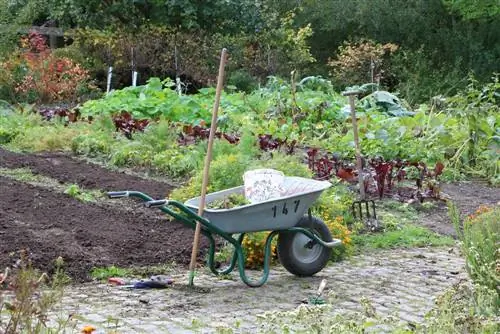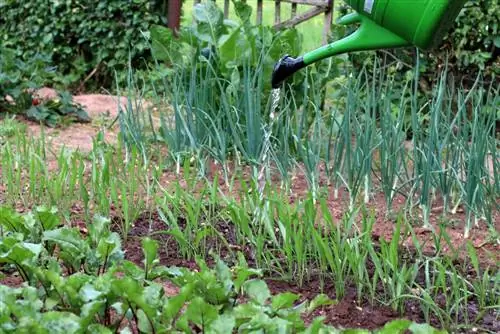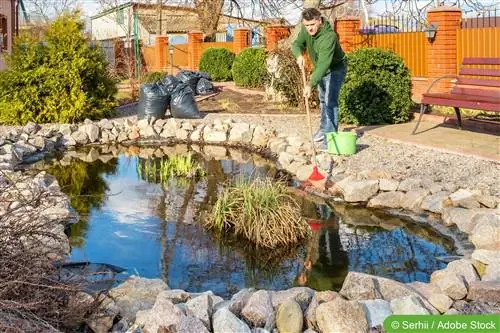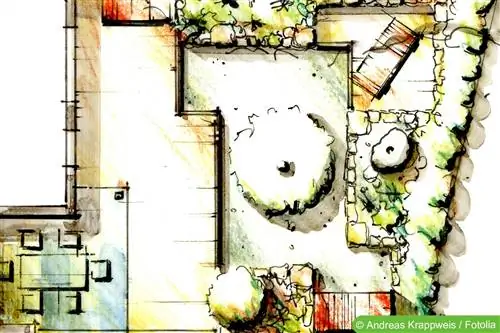- Author admin [email protected].
- Public 2023-12-17 03:39.
- Last modified 2025-01-24 12:45.
A pond in the garden brings rest and relaxation, but until then a few things should be taken into account. Once built, it should meet the requirements, as changes are then usually difficult to make. Therefore, it is better to take some time when planning and perhaps get a second opinion. Because an outsider sees many things that would otherwise be overlooked. Of course, this can also be a good friend who may also have a little bit of mechanical talent and would be happy to help with the construction.
Plan the location exactly
Above all, it should be clear whether it is a swimming pond or one for fish. The location is crucial, especially with a pond for swimming, as it then needs the sun so that the water can warm up. If it is a fish pond, the fish are important because they then determine the depth. Here, partial shade is recommended so that the fish and plants are not always in the sun. The size of the pond is just as important as the location, as later corrections are more than annoying. Such changes are often associated with high costs and of course with the annoyance of having another construction site in the garden. Therefore, you should decide straight away what type of pond it is so that no changes have to be made later. Of course, the terrain should also be marked out, so that changes can be made before the first sod is turned.
Fish or ornamental pond?
If you want fish in the pond, it is crucial that there are not too many. Because here you have to use a pond pump and a lot of effort to ensure that the water is always kept in balance. Therefore the size is also crucial here and of course the planting. Few fish, on the other hand, bring life into the pond without changing the water ratio. Naturally left ponds can regenerate themselves with the right plants. How good the water is is shown by other inhabitants who then settle, such as frogs, birds and insects. But a swimming pond can also be embellished with various plants, which also keep the water in balance.
Divide the pond into zones
If the pond is planned correctly, it should have three zones. The lowest one is also the coolest and should then be at least 50-60 cm. The second zone has a depth of 20-30 cm. Then the third and uppermost zone is only 10 or 20 cm deep. With this information, a shallow and small pond can easily be planned, which of course also has to do with the size of the garden and the actual needs. An ornamental pond can simply be up to 20 cm deep and still fulfill all your wishes for an oasis of peace.
Of course, such a small pond can still be dug with a spade, but if the pond gets larger, an excavator is better. An experienced excavator operator can do the excavation in one day, but with muscle power it can take a little longer. Without the sore muscles and frustration, it's easier and faster with Bagger. The edge must not slope too steeply, and therefore a small step should be planned here too. Gently sloping just like in nature, maybe add a small step here at the edge so that the edge slopes gently.
Pond liner or prefabricated shape
Both options exist, but the foil is better with a free design. The right space then has to be dug out for the shape, although not as much preparatory work is necessary. Before the film can be laid out, roots and stones must first be removed so that it is not damaged. Of course, this is also important for the finished shape so that the pond doesn't end up crooked afterwards. A slope fleece should also be purchased so that the pond liner is protected and at the same time lasts longer. The roots of the plants on the bank have a better grip because the mat can be rooted through. Coconut mats also have the same effect, which are of course also available to buy by the meter.
Design the path with stone foil
- The transition from the pond to the garden is often a little difficult to make.
- It's easier with stone foil, which is actually covered with small stones.
- Simply lay it out over the pond liner and glue it and the path is quickly ready.
- Of course, everyone can design it individually using stones, which of course requires some work.
Of course, a beautiful pond also includes stones, which can then be purchased in different sizes. A pond without the right plants would not be a beautiful sight and therefore the planting must also be planned. Here you can also decide whether a pump is necessary or not. Of course, this also depends on whether fish should be added to the pond.
Plan a stream right away
Especially with a pond, a small stream is still a special highlight, but it should be planned straight away. There are no limits to your imagination when designing and planning a pond, as long as the garden is large enough. Not only does the pond need space, but also the bank embankment and the corresponding plants in and around the pond. Therefore, the planting zones must also be planned into the pond so that the plants can find everything that is really important for survival.
What you should know about pond planning in brief
Pond size and structure
The area around the pond should also be included in the planning: a swamp zone or a small wet meadow afterwards to round it off are ideal. It is important to find the right location. The terrain should be as flat and sunny as possible. Of course, size, especially depth and shape of the pond are also crucial. If you also want to provide a habitat for small creatures, you should plan the pond with three zones of different depths:
- In the middle it should be at least 60 cm deep, deeper is better.
- Then fish can overwinter in the pond and water lilies feel comfortable.
- The second zone should be 20 to 50 cm deep.
- The third zone is the shallow shore zone.
- The transitions are designed gently, with a maximum gradient of 50 percent.
- If the gradient is higher, the earth will slip.
If you want to use fish, you should choose local schooling fish. As the name suggests, it should be a school, at least 10 to 15 fish. With their high nutrient input, goldfish quickly cause the pond to become unsightly.
Pond materials
The most natural material for pond sealing is clay. However, the clay layer must be thick, at least 30 cm. Otherwise, settling cracks can occur and roots can penetrate the clay. There are now pre-formed clay elements. They just have to be interlocked and tamped down layer by layer. Clay ponds are very natural.
- Concrete ponds last forever if they are constructed correctly. If you want to change something about them, you have to use a jackhammer. However, it is not that easy to correctly insert the structural steel mats required for stabilization.
- A concrete pond also needs a coat of paint to protect it from dissolution by acids contained in the water. This paint needs to be renewed every few years.
- Prefabricated ponds made of hard plastic are the easiest to install. The only thing to note here is that the pond pit is adapted to the dimensions of the bowl. Otherwise everything is very simple.
- Film ponds are the most common. This is because almost any shape and size is possible. The prices are also acceptable.
- Prefabricated (pre-welded) standard films are often cheap. Custom-made products are significantly more expensive. Don't forget a protective fleece that protects against damage from roots and stones.






